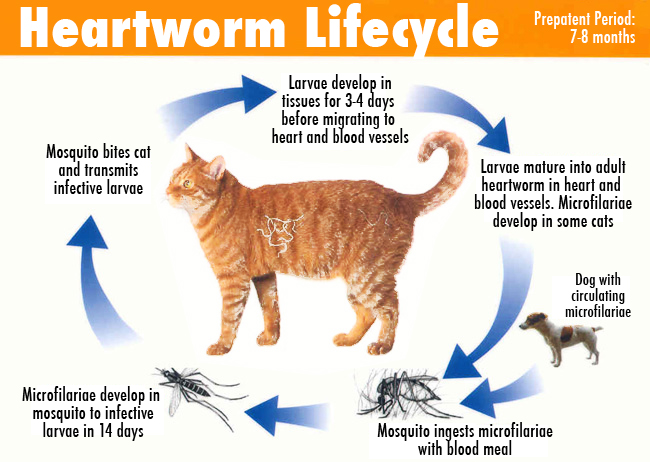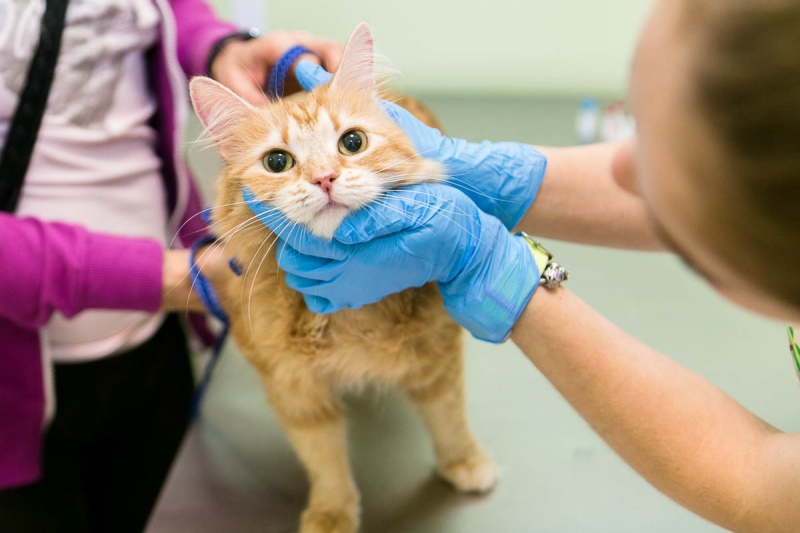Even children know that the worms live in the intestines of the infected person or animal. If you have a deeper knowledge of veterinary medicine, biology or medicine, you know that certain types of parasites can live in the lungs and the liver. But almost all breeders are deeply amazed to learn that there are even heartworms in cats.
Contents
General information
In veterinary medicine this disease is called dirofilariasis. Initially, the disease was spread exclusively in North America, but gradually it spread much wider. Pathology is caused by helminths from the genus Dirofilaria, capable of living in the heart, lungs and large blood vessels.
Often, the disease is very difficult, the sick animal develops severe disruption of the cardiovascular system, which in itself can lead to death. In addition, parasites throughout the life cycle release a huge amount of toxins, which, due to the “unusual” location of the worm, get directly into the blood.
Important! They are dangerous to humans, not to mention dogs, cats, ferrets and other wild and domestic animals. So far, scientists have not yet compiled a final list of mammals that may prove to be intermediate and final hosts of parasites.
Features of the disease
Infection with cardiac worms in cats is very different from the same disease of dogs. Their advantage lies in the fact that the organism of animals from the cat family for some reason is not an ideal “haven” for dirofilariae, and therefore more than 70% of the larvae that enter the cat’s body do not live to adulthood. As a rule, a cat is found to have one, at most – two worms, no more. But not everything is so “rosy”. First, it means that in more than 90% of cases the infection remains unidentified. Secondly, the remaining worms continue to poison the animal’s body with toxins, which does not benefit the pet.
So prevention is, in fact, the only way to protect your pet. But in order to know how to prevent infection, it is necessary to have at least a general idea of the cycle of development of the parasite.
How does the infection occur?
In the life cycle of helminth the most important role is played by blood-sucking insects, especially mosquitoes and mosquitoes. Adult females (yes, these dioecious sex parasites) are vivacious, and therefore, having reached the sexually mature state and mating with the male (if any) begin to release “ready” larvae, called microfilariae, into the bloodstream. When a sick animal bites a mosquito, young parasites get into the body along with blood. In the intestine of the bloodsucker they spend from 10 to 14 days (depending on the weather conditions and air temperature), during which the rapid development of worms. Subsequently, when the mosquito bites a healthy animal, the larvae enter the bloodstream of the new host, along with the saliva mosquito.
Once in the body of a new host, the helminth reaches the heart or pulmonary arteries, is fixed there and begins to intensively feed and grow. To grow to the mature stage, it takes at least six months. In the body of cats, the parasite rarely reaches the age of two or three years. There is one curious property in adult worms. When they are already in the body of an animal, new microfilariae entering the bloodstream with the bites of infected mosquitoes die. There is a simple evolutionary device: a parasite is unprofitable for its owner to perish, and therefore his body produces substances that impede the growth and development of “young animals.” By the way, a similar phenomenon is observed in round and flat parasitic worms.
Symptoms
What are the symptoms of cardiac worms in cats? Symptoms of infection may not be, but in some animals they appear very brightly. Symptoms may include: coughing, asthma-like attacks, recurrent vomiting, weight loss and decreased appetite.
Occasionally, a cat that has fallen ill can experience difficulty walking, it may have syncope, rarely ascites (dropsy of the abdominal cavity). Unfortunately, due to the absence or vagueness of the “clinic”, many pets have the first and only sign of infection is sudden death.
Since the cat is not an ideal host for cardiac worms, veterinary periodicals also describe many cases of spontaneous recovery. But such situations make up no more than 3-5% of the total number of infections.
This – a fairly “serious” indicators, but still rely on such a happy outcome is not worth it. Cardiac worms in the cardiovascular system also affect the immune system of the cat and very often contribute to the development of diseases of the respiratory system. As a result, chronic patients develop chronic cough, shortness of breath, and possible pulmonary edema. There are also cases when the dirofilaria appeared in the eyes, spinal cord and even the brain! The reasons for this are trivial – during the migration period, larvae can be anywhere, because they travel through the body with a blood stream.
Remember that we talked about cases of self-recovery? Probably, many sudden deaths of sick cats occur just as a result of this. It’s simple. When a worm in the largest and most important blood vessels of a cat dies, its body, unfortunately, does not annihilate. The corpse of the parasite decomposes and breaks up into pieces. And this is the multiply increased risk of thrombosis. So with any suspicions of having these “guests” in your pet’s body – immediately to the vet!
Diagnosis and treatment
However, an experienced veterinarian may suspect that something is wrong already during the general medical examination, radiography and ultrasound. Adult worms with these methods of research can be seen very well. Finally, there is a fairly effective way of detecting parasites in the course of a serological blood test. The fact is that the cat’s body is trying to destroy the helminth, and in the course of a complex immune reaction, specific antibodies are formed.
When they are detected, it is possible to assert with confidence about 40% of the presence of dyrofilariasis in a cat. But not everything is so simple. First, antibodies are not formed immediately. Can go up to four months from the time of infection. Secondly, sometimes they are just evidence of getting into the body of a cat of microfilariae. Adult parasites in the pet may not be.
Is there any effective treatment? Unfortunately, unlike dogs, for the treatment of which a fairly wide range of drugs is used, cats have been “deprived”. None of the drugs that are used for dogs, is not at all somewhat safe for cats.
The main task of the veterinarian is to stabilize the pet’s condition and minimize the harm that is inflicted on his body by the parasite. But there is a hope that over time experts will learn to completely rid the cats of this disease. In particular, today the methods of surgical removal of worms are being improved.
To solve this problem, it is necessary to follow a brief list of basic rules:
• A cat needs to provide quality care. If your cat does not show signs of respiratory distress syndrome, but worms have been found in the lungs, it is recommended to bring your pet to x-ray every six months. In cases where the disease does not tend to deteriorate sharply, it is recommended that small doses of prednisolone be administered. This anti-inflammatory corticosteroid helps to stop inflammatory processes.
• Always have the phone of an experienced veterinarian at hand – his cat may need help at any time. If you see that your pet is getting worse, immediately call a specialist. In such cases it is recommended that a sick cat be transferred to a clinic. He will need intravenous injection of drugs that remove intoxication, drugs to normalize the cardiovascular system, as well as antibiotics to prevent secondary bacterial infections.
• Preventive maintenance – first of all. It is important to understand that if you live in an area where there are at least several cases of heartworm infection, your cat (and you yourself) is in danger. Fortunately, it is easy to prevent infection of the cat – in the early stages of microfilaria it is perfectly destroyed by small doses of ivermectin and similar preparations. In addition, it is highly recommended to treat the cat with repellents whenever you release it to the street during the mass summer of bloodsucking insects.





















